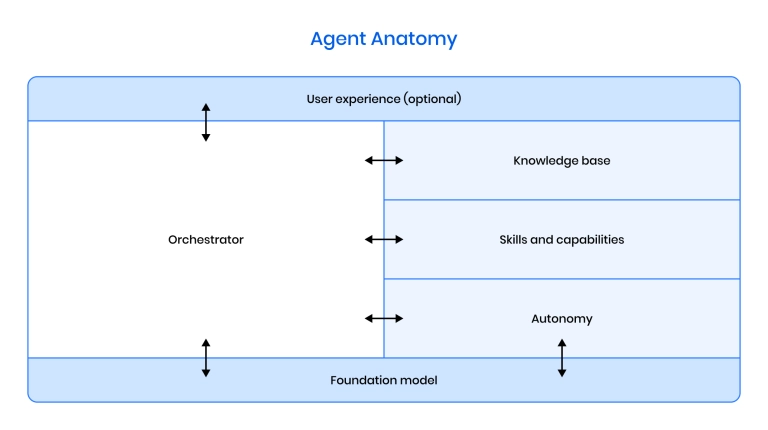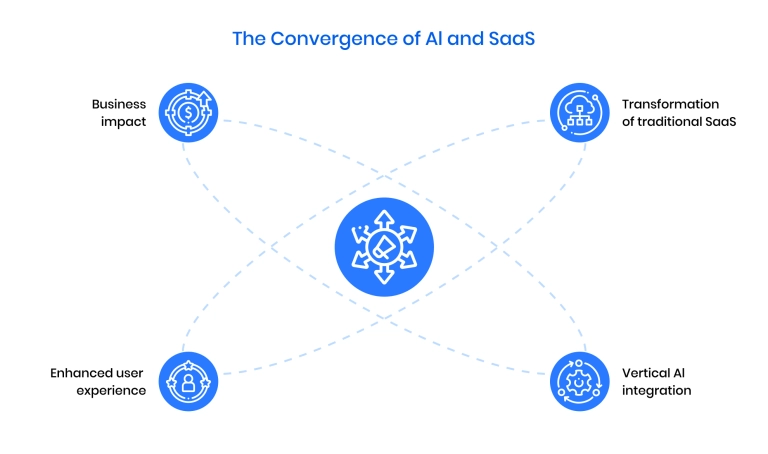SaaS workflows often start simple — until coordination between tools, data, and decisions breaks down. Teams end up duct-taping APIs, rewriting logic for every integration, and relying on brittle automations that constantly need fixing. This is where MCP AI in SaaS offers a real solution. By structuring communication between intelligent agents — each handling a specific task — the Model Context Protocol (MCP) enables dynamic, composable workflows that adapt in real time. Instead of rebuilding backend logic for every use case, teams can chain agents through MCP and get faster results with less manual oversight.
In this article, you'll learn:
- What workflow bottlenecks slow SaaS teams down
- How MCP enables AI agents to cooperate without hardcoding
- Real examples of agentic flows in SaaS platforms
- What it takes to build your own agentic workflow
- How Binariks supports SaaS companies using MCP
Let's dive in and see how to simplify SaaS — without rebuilding the whole engine.
Let AI agents handle tasks, you lead strategy
SaaS workflow bottlenecks that AI agents can solve
As SaaS workflows grow more complex, rule-based automations start to break under real-world variability, requiring manual handoffs, risky updates, and constant patching. This is where MCP AI in SaaS changes the game.
Instead of relying on brittle pipelines, teams can deploy modular agents that reason, adapt, and collaborate through the Model Context Protocol.
As highlighted in our article about adaptive AI , these agents access shared memory, knowledge, and skills — all coordinated by an orchestrator that keeps workflows fluid, not fragile.
Key bottlenecks AI agents help solve:
- Manual decision points — approvals, escalations, and exceptions often rely on human judgment that slows everything down.
- Static rule systems — logic is hardcoded, making it inflexible when business needs change.
- Automation silos — tools like Zapier or Make don't communicate well with each other or external systems.
- Integration sprawl — every new tool adds another API, which means another fragile point in the workflow.
- Error recovery — when automations fail, they often stop completely or require manual restarts.

The MCP SaaS approach tackles all of this by letting agents specialize. Orchestrators handle flow and coordination. Individual agents perform tasks like approvals, enrichment, and triage. As described here, this distributed architecture gives SaaS teams flexibility without losing control — making workflows resilient, scalable, and finally manageable.
The power of MCP: Workflow chaining without rebuilding
One of the biggest challenges in SaaS architecture is the high cost of change — adding new logic often means editing core code, rebuilding flows, or relying on brittle integrations.
The MCP protocol for SaaS addresses this by providing a shared interface that lets agents communicate, pass context, and delegate tasks without disrupting existing systems. Instead of building monolithic scripts, teams can chain specialized agents — one for parsing, another for validation, another for response — all coordinated through a structured, memory-aware context.
This makes workflows composable and flexible. As a result, AI agents in SaaS can work dynamically, responding to user input, system state, and business logic in real time, without hardcoded rules or constant rewrites. According to Cline blog, "MCP servers act as intermediaries between large language models (LLMs) and external tools or data sources. They're essentially APIs that LLMs can use to interact with the outside world."
That's exactly what makes agent chaining possible without the usual architectural friction. Instead of hardwiring workflows, SaaS teams can plug agents into the system like modular components — each communicating through MCP, handling specific tasks, and evolving independently. For fast-moving products, this means you can adapt quickly without ripping out what's already working — scaling logic, not just code.
Integrating approval logic, APIs, and external systems
As SaaS platforms scale, their workflows touch everything — internal tools, customer-facing systems, external APIs, and manual review steps.
But layering all that into one coherent flow without breaking things? That's the real challenge. This is where the MCP for SaaS automation becomes a practical tool. It lets agentic components interact with diverse systems while maintaining a clean separation of logic, execution, and orchestration.
Here's how MCP enables complex integration without compromising stability:
- API calls to third-party services: Agents can make real-time requests to payment providers, CRMs, or internal microservices, all routed through a shared context layer. No hardcoded workflows, no brittle glue logic.
- Direct database access or query delegation: Instead of forcing everything through the frontend, agents can pull or write data from structured sources while preserving context and auditability.
- Manual approval steps: Need a human-in-the-loop? Agentic workflows can pause execution, notify the right person, and resume based on input, without losing track of the workflow's state.
- Context-aware fallback logic: Agents can reroute or escalate without breaking the flow if an API is down or a condition fails. This makes the system more resilient by design.
- Secure, scalable handoffs between systems: With MCP acting as the shared protocol, agents working across environments (e.g., cloud + on-premise) can still collaborate securely and predictably.
This form of SaaS automation with MCP creates room for complexity without chaos. It's a foundational enabler for agentic workflows for SaaS, where humans, APIs, and data all play their roles. Teams that invest in AI/ML development can use these patterns to build smarter orchestration without central bottlenecks — and future-proof their systems as they grow.
Real-world examples: Agentic workflows in action
MCP and AI agents are already transforming how SaaS products handle complexity. From dynamic approvals to billing automation, they power smarter workflows, replacing manual bottlenecks with adaptive logic.
1. Zurich Insurance
What they did: Zurich overhauled its CRM by building an AI-driven platform that connects Salesforce, Outlook, and internal policy systems. Agents automatically surface customer history, suggest personalized next steps, and minimize manual lookup during client interactions.
Why: The system dynamically pulls data across tools and adapts to each conversation, removing the need for rigid workflows. It's a clear example of intelligent SaaS workflows powered by agent-like behavior.
Result: Zurich reports up to 70% faster service handling times, stronger customer loyalty, and a CRM that supports agents without slowing them down.
2. Charta Health
What they did: Charta Health developed an AI-powered platform that automates patient chart reviews to identify missed billing codes and prevent claim denials. The system analyzes clinical documentation by leveraging AI agents to ensure accurate and complete coding before submission.
Why: Manual chart reviews are time-consuming and prone to errors, leading to revenue loss and increased administrative burden. Charta's solution streamlines this process, allowing healthcare providers to optimize billing workflows and reduce the risk of denied claims.
What was the result: Within 60 days of launching, Charta Health achieved $500,000 in revenue and reached profitability. Their AI-driven approach has enabled providers to capture more revenue and decrease administrative workload.
These examples show that agentic workflows are not just technically elegant — they deliver tangible business results. By combining modular AI agents with context-aware orchestration, whether surfacing real-time context in CRM, automating invoice logic, or streamlining approvals, approval logic in SaaS no longer needs to rely on brittle rule trees or human bottlenecks. Instead, workflows evolve intelligently, led by agents that reason, adapt, and act autonomously.
What it takes to build your own agentic workflow
With the proper structure and tools, companies can embed intelligent behavior gradually, aligning it with current backend logic, workflows, and security constraints. Here’s what the process typically looks like.
1. Plan your context and workflow boundaries
Before writing any code, clearly define the scope. What parts of your workflow are repetitive, rules-based, or require contextual decision-making? Which agents will need to share memory or work in sequence? Early planning reduces downstream complexity and helps prevent logic sprawl — a common challenge in saas ai workflow orchestration.
2. Choose your tools and protocol layer
Select the tools that support modular agent orchestration. MCP SDKs (such as those from Anthropic), LangGraph, LangChain, or CrewAI can manage context, handle messaging, and support structured flows. These tools let you design systems that scale and evolve, without introducing brittle dependencies or tight coupling.
3. Develop modular backend logic for each agent
Each agent should handle one responsibility: calling an API, validating inputs, checking inventory, flagging risk, or formatting output. This modular approach makes it easier to update or replace specific agents later, without refactoring the entire system. Well-scoped agents are easier to test, debug, and deploy incrementally.
4. Validate security, UX, and governance
Agentic flows often interact with sensitive data or trigger user-facing actions. Build guardrails early. Define what agents can and cannot do, track inputs and decisions, and design fallbacks for edge cases. Involve your product and security teams to ensure agent behavior aligns with your trust and UX standards. This becomes even more important when using AI agents in saas platforms that touch payments, approvals, or legal workflows.
5. Deploy gradually
You can introduce agentic logic into a single use case: onboarding, approval, billing, or triage. Run it in parallel to your existing system and monitor performance. Many teams find that adoption scales naturally once the first agent chain works well. MCP is designed to layer over existing infrastructure, not to replace it.

How Binariks helps SaaS orchestrate agentic flows
At Binariks, we've helped SaaS companies design and implement agent-based systems that fit into real products, not just prototypes. Our teams have experience integrating tools like LangGraph, CrewAI, and Anthropic’s SDKs into complex architectures, building agent chains that handle approvals, dynamic API calls, document parsing, and decision logic.
We don't just drop in a model — we shape workflows around real constraints: performance, security, UX, and long-term maintainability. We support our partners through every step of workflow orchestration with MCP — from early-stage technical planning to modular backend development and production deployment. Whether testing a single-agent pilot or building a multi-agent system with cross-system context sharing, our engineers focus on practical design that works at scale.
The result: more intelligent automation, faster rollout, and reduced risk as you adopt agentic infrastructure.
Share

